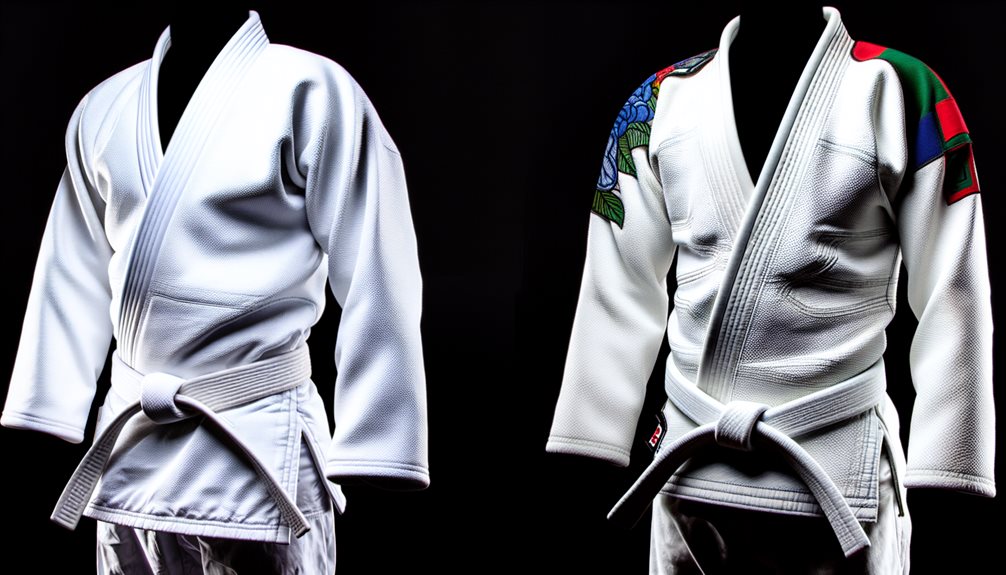Martial artists examining uniform options often confront the judo gi versus BJJ gi question. These seemingly similar garments contain distinct engineering differences that impact performance across disciplines. The fabric weight, cut, collar design, and reinforcement patterns serve specific technical purposes within each art’s competitive framework. Understanding these seven key differences helps practitioners select equipment that enhances their training advantages. The technical specifications of each uniform reveal how equipment evolution mirrors the divergent development paths of these related grappling arts.
Fabric Weight and Thickness
When comparing judo and BJJ gis, the most noticeable difference lies in their fabric weight and thickness.
Judo gis typically feature heavier construction (900-1200 gsm) with reinforced stress points to withstand aggressive gripping and throwing techniques. BJJ gis, conversely, tend to be lighter (350-550 gsm) to enhance fabric breathability during extended ground-based training sessions.
This weight distinction affects performance and washing care requirements.
Judo gis’ thicker weave requires longer drying times and more rigorous washing to remove embedded sweat and bacteria. BJJ practitioners often prefer their lightweight gis for comfort during technical training, while judokas rely on durability for competition-standard requirements.
Jacket Cut and Length
The structural differences between judo and BJJ gi jackets extend beyond mere fabric composition to their fundamental design parameters.
Judo gis typically feature longer, looser-fitting jackets that extend to mid-thigh, facilitating grip breaks and throwing techniques. This traditional style prioritizes mobility during stand-up exchanges.
Conversely, BJJ gis adopt a more tailored approach with shorter, slimmer-cut jackets ending near the hip line. These style variations minimize excess fabric that opponents might grip during groundwork.
Modern BJJ jacket fit often incorporates tapered sleeves and torso dimensions that conform closer to the practitioner’s body, reflecting the sport’s focus on ground-based positional control.
Sleeve Dimensions and Reinforcement
Sleeve construction represents another critical differentiation between judo and BJJ uniforms. Judo gis typically feature wider sleeves with greater sleeve width to facilitate grip-fighting and throwing techniques. This design allows opponents to establish secure grips during competition.
In contrast, BJJ gis are engineered with narrower, more tapered sleeves and reduced sleeve length, making it harder for opponents to secure and maintain grips.
BJJ sleeve reinforcement often extends from the armpit to the cuff with additional stitching at stress points. These structural modifications reflect the sport’s ground-fighting emphasis, where limiting an opponent’s gripping opportunities provides tactical advantages during grappling exchanges.
Collar Construction and Stiffness
Differing considerably between disciplines, collar construction and stiffness represent key design features that distinguish judo gis from BJJ gis.
Judo gi collars typically feature stiffer, thicker construction designed to withstand powerful gripping during standing exchanges. This reinforced collar material prevents deformation during competition.
BJJ gi collars, while still durable, tend to be more flexible and slightly thinner, accommodating the frequent collar grips and chokes employed in ground fighting.
The collar function in BJJ requires balance between rigidity for longevity and pliability for technical applications, whereas judo collars prioritize structural integrity under explosive gripping scenarios.
Pants Design and Mobility Features
Pants construction between judo and BJJ gis reveals significant functional differences tailored to each discipline’s movement requirements.
Judo pants typically feature a looser fit with reinforced knees to accommodate explosive throwing techniques and wide stance shifts. The extra material allows unrestricted mobility range during dynamic movements.
BJJ gi pants, conversely, offer a more tapered design that reduces fabric grabbing opportunities for opponents.
These pants commonly include additional reinforcement panels extending from knee to ankle and strategic gussets that enhance mobility range while maintaining a closer fit. The tighter construction supports the ground-focused nature of Brazilian Jiu-Jitsu, where practitioners need controlled movement without excess material.
Competition Regulation Differences
Competition regulations governing gi specifications differ substantially between judo and BJJ, creating distinct requirements that practitioners must navigate when competing in either sport.
Judo follows IJF standards stipulating specific gi dimensions relative to weight classes, with strict enforcement regarding sleeve length, jacket overlap, and overall thickness.
BJJ competition rules generally allow more flexibility, particularly in non-IBJJF events, permitting varied sleeve widths and material compositions.
While both sports regulate gi color (primarily white, blue, and black in BJJ; white and blue in judo), judo’s measurement protocols include precise fabric weight standards that BJJ competitions typically don’t enforce.
Durability and Grip Resistance
Although both are designed for grappling sports, BJJ and judo gis exhibit significant differences in durability and grip resistance characteristics.
Judo gis typically feature thicker, stiffer fabric with reinforced collar and lapel areas to withstand aggressive gripping techniques and frequent throwing.
BJJ gis prioritize abrasion resistance through strategic reinforcement at stress points—particularly knees, lapels, and shoulders—as ground-based training creates different wear patterns.
The material composition often differs as well; BJJ gis increasingly utilize ripstop fabrics and specialized weaves that reduce grip retention, whereas judo gis maintain traditional heavy cotton construction optimized for competition-legal specifications.

